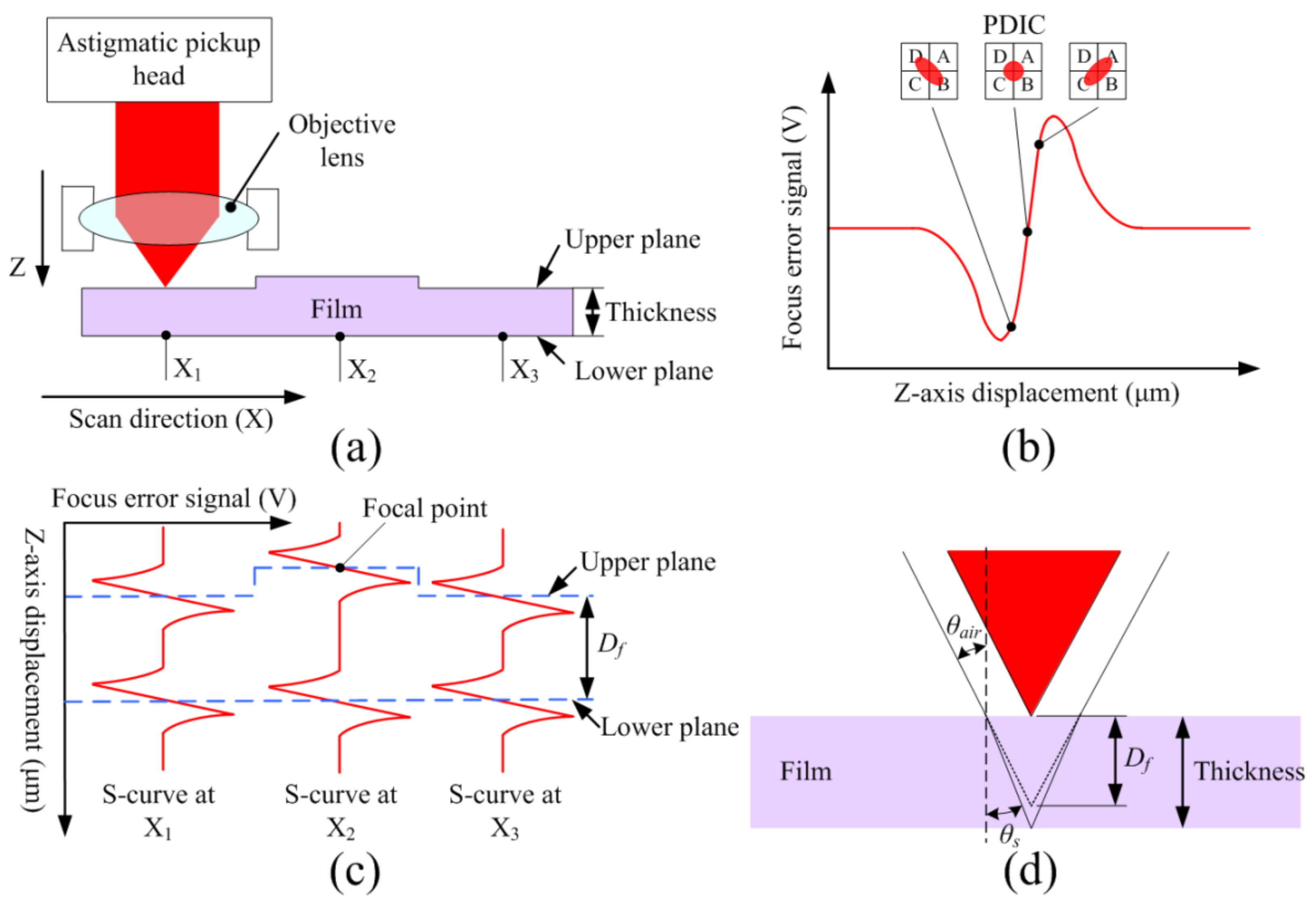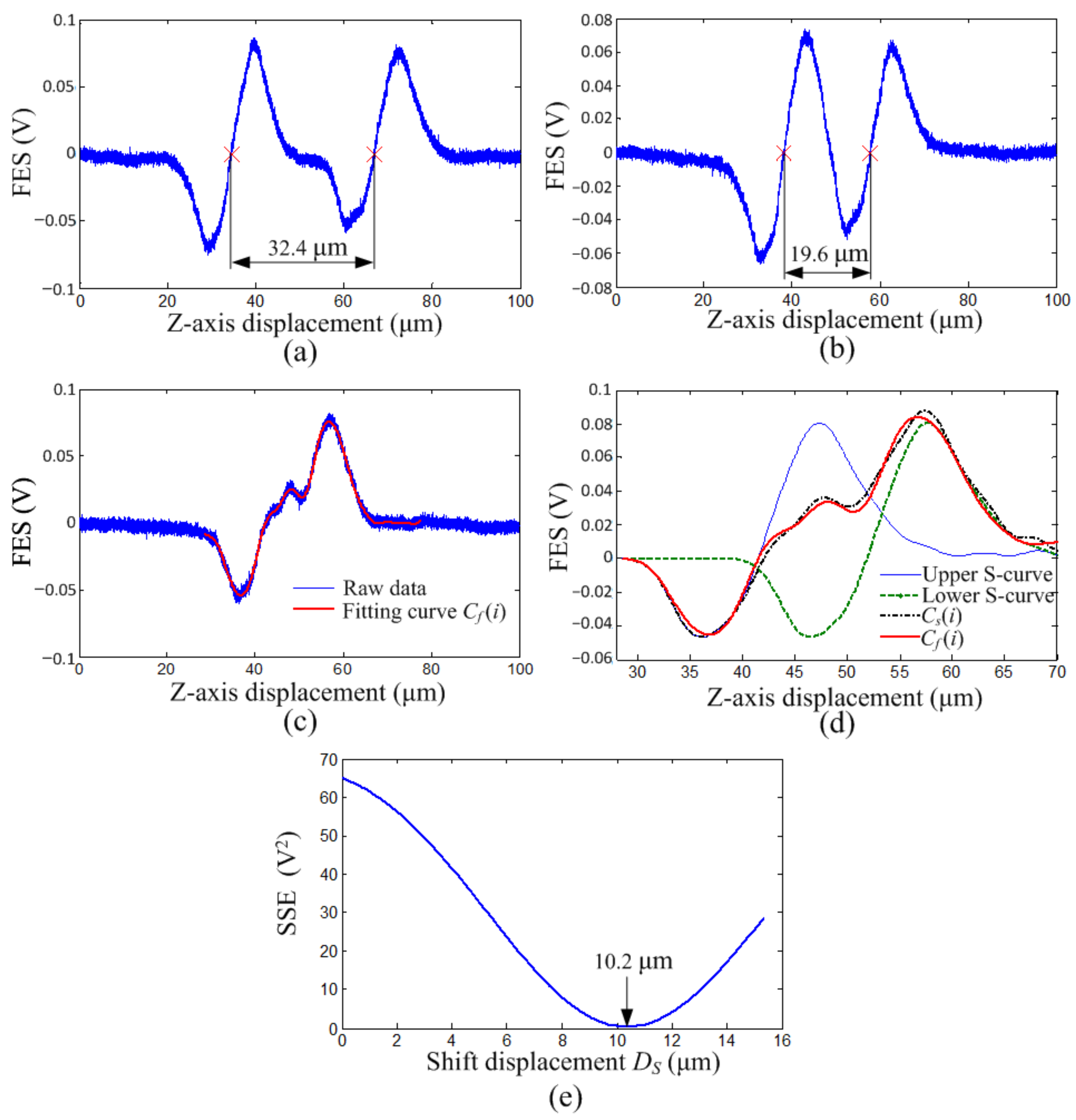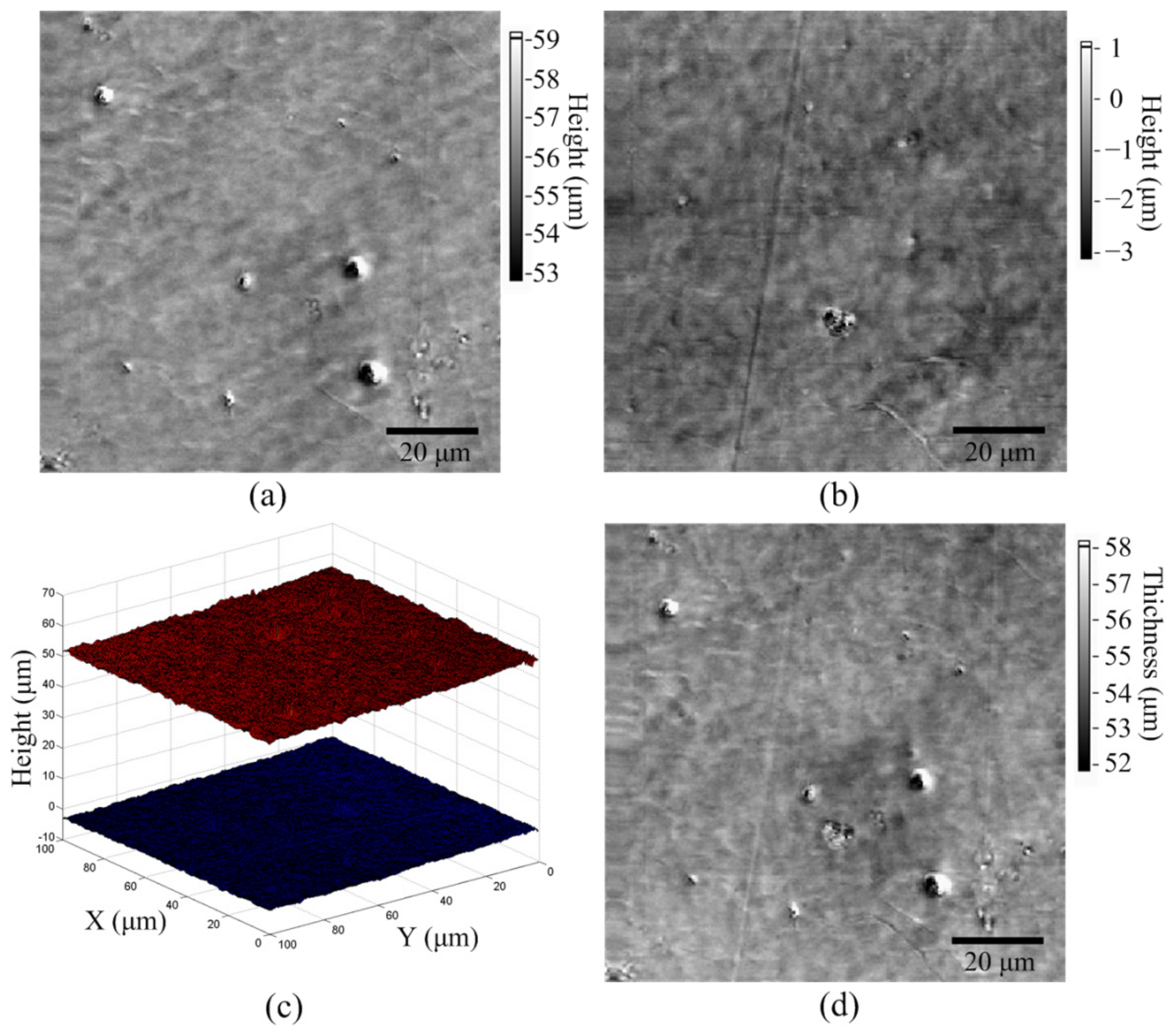Method for Film Thickness Mapping with an Astigmatic Optical Profilometer
Abstract
:1. Introduction
2. Materials and Methods
2.1. Thickness Calculation Method
2.2. Decoupling of S-Curves
2.3. Astigmatic Optical Profilometer
3. Results and Discussion
3.1. Single-Point Film Thickness Measurement
3.2. 3D Imaging
4. Conclusions
Author Contributions
Funding
Institutional Review Board Statement
Informed Consent Statement
Conflicts of Interest
References
- Branchet, M.C.; Boisnic, S.; Frances, C.; Robert, A.M. Skin thickness changes in normal aging skin. Gerontology 1990, 36, 28–35. [Google Scholar] [CrossRef] [PubMed]
- King-Smith, P.E.; Fink, B.A.; Hill, R.M.; Koelling, K.W.; Tiffany, J.M. The thickness of the tear film. Curr. Eye Res. 2004, 29, 357–368. [Google Scholar] [CrossRef] [PubMed]
- Cwiklik, L. Tear film lipid layer: A molecular level view. Biochim. Biophys. Acta 2016, 1858, 2421–2430. [Google Scholar] [CrossRef] [PubMed]
- Wen, P.J.; Grenklo, S.; Arpino, G.; Tan, X.; Liao, H.S.; Heureaux, J.; Peng, S.Y.; Chiang, H.C.; Hamid, E.; Zhao, W.D.; et al. Actin dynamics provides membrane tension to merge fusing vesicles into the plasma membrane. Nat. Commun. 2016, 7, 12604. [Google Scholar] [CrossRef] [Green Version]
- Chan, T.C.; Ye, C.; Ng, P.K.; Li, E.Y.; Yuen, H.K.; Jhanji, V. Change in Tear Film Lipid Layer Thickness, Corneal Thickness, Volume and Topography after Superficial Cauterization for Conjunctivochalasis. Sci. Rep. 2015, 5, 12239. [Google Scholar] [CrossRef] [Green Version]
- Pendergast, M.M.; Hoek, E.M.V. A review of water treatment membrane nanotechnologies. Energy Environ. Sci. 2011, 4, 1946. [Google Scholar] [CrossRef] [Green Version]
- Sengupta, D.; Das, P.; Mondal, B.; Mukherjee, K. Effects of doping, morphology and film-thickness of photo-anode materials for dye sensitized solar cell application—A review. Renew Sustain. Energ. Rev. 2016, 60, 356–376. [Google Scholar] [CrossRef]
- Liu, C.; Zhang, Q.; Wang, D.; Zhao, G.; Cai, X.; Li, L.; Ding, H.; Zhang, K.; Wang, H.; Kong, D.; et al. High Performance, Biocompatible Dielectric Thin-Film Optical Filters Integrated with Flexible Substrates and Microscale Optoelectronic Devices. Adv. Optical Mater. 2018, 6, 1800146. [Google Scholar] [CrossRef]
- Pan, Y.; Liu, H.; Zheng, Z. Design and fabrication of optical filters for infrared imaging temperature measurement. Optik 2021, 247, 167994. [Google Scholar] [CrossRef]
- Kottapalli, A.G.P.; Tan, C.W.; Olfatnia, M.; Miao, J.M.; Barbastathis, G.; Triantafyllou, M. A liquid crystal polymer membrane MEMS sensor for flow rate and flow direction sensing applications. J. Micromech. Microeng. 2011, 21, 085006. [Google Scholar] [CrossRef]
- Wang, D.; Ba, D.; Hao, Z.; Li, Y.; Sun, F.; Liu, K.; Du, G.; Mei, Q. A novel approach for PDMS thin films production towards application as substrate for flexible biosensors. Mater. Lett. 2018, 221, 228–231. [Google Scholar] [CrossRef]
- Piegari, A.; Masetti, E. Thin film thickness measurement: A comparison of various techniques. Thin Solid Films 1985, 124, 249–257. [Google Scholar] [CrossRef]
- Benoit, M.; Bataillon, C.; Gwinner, B.; Miserque, F.; Orazem, M.E.; Sánchez-Sánchez, C.M.; Tribollet, B.; Vivier, V. Comparison of different methods for measuring the passive film thickness on metals. Electrochim. Acta 2016, 201, 340–347. [Google Scholar] [CrossRef] [Green Version]
- Giurlani, W.; Berretti, E.; Innocenti, M.; Lavacchi, A. Measuring the Thickness of Metal Coatings: A Review of the Methods. Coatings 2020, 10, 1211. [Google Scholar] [CrossRef]
- Shearer, C.J.; Slattery, A.D.; Stapleton, A.J.; Shapter, J.G.; Gibson, C.T. Accurate thickness measurement of graphene. Nanotechnology 2016, 27, 125704. [Google Scholar] [CrossRef]
- Giurlani, W.; Berretti, E.; Lavacchi, A.; Innocenti, M. Measuring the Thickness of Metal Films: A Selection Guide to the Most Suitable Technique. Mater. Proc. 2020, 2, 6823. [Google Scholar]
- Isić, G.; Jakovljevic, M.; Filipovic, M.; Jovanovic, D.M.; Vasic, B.; Lazovic, S.; Puac, N.; Petrovic, Z.L.; Kostic, R.; Gajic, R.; et al. Spectroscopic ellipsometry of few-layer graphene. J. Nanophotonics 2011, 5, 051809. [Google Scholar] [CrossRef]
- Garriga, M.; Alonso, M.I.; Dominguez, C. Ellipsometry on very thick multilayer structures. Phys. Stat. Sol. 1999, 215, 247–251. [Google Scholar] [CrossRef]
- Fodor, B.; Agocs, E.; Bardet, B.; Defforge, T.; Cayrel, F.; Alquier, D.; Fried, M.; Gautier, G.; Petrik, P. Porosity and thickness characterization of porous Si and oxidized porous Si layers—An ultraviolet–visible–mid infrared ellipsometry study. Microporous Mesoporous Mater. 2016, 227, 112–120. [Google Scholar] [CrossRef] [Green Version]
- Rosu, D.-M.; Ortel, E.; Hodoroaba, V.-D.; Kraehnert, R.; Hertwig, A. Ellipsometric porosimetry on pore-controlled TiO2 layers. Appl. Surf. Sci. 2017, 421, 487–493. [Google Scholar] [CrossRef]
- Secondo, R.; Fomra, D.; Izyumskaya, N.; Avrutin, V.; Hilfiker, J.N.; Martin, A.; Özgür, Ü.; Kinsey, N. Reliable modeling of ultrathin alternative plasmonic materials using spectroscopic ellipsometry [Invited]. Opt. Mater. Express 2019, 9, 760. [Google Scholar] [CrossRef]
- Li, H.; Cui, C.; Xu, X.; Bian, S.; Ngaojampa, C.; Ruankham, P.; Jaroenjittchai, A.P. A review of characterization of perovskite film in solar cells by spectroscopic ellipsometry. Sol. Energy 2020, 212, 48–61. [Google Scholar] [CrossRef]
- Hwu, E.T.; Hung, S.K.; Yang, C.W.; Huang, K.Y.; Hwang, I.S. Real-time detection of linear and angular displacements with a modified DVD optical head. Nanotechnology 2008, 19, 115501. [Google Scholar] [CrossRef] [PubMed]
- Hwu, E.T.; Illers, H.; Jusko, L.; Danzebrink, H.U. A hybrid scanning probe microscope (SPM) module based on a DVD optical head. Meas. Sci. Technol. 2009, 20, 084005. [Google Scholar] [CrossRef]
- Kim, S.-W.; Kim, G.-H. Thickness-profile measurement of transparent thin-film layers by white-light scanning interferometry. Appl. Opt. 1999, 38, 5968–5973. [Google Scholar] [CrossRef] [PubMed]
- An, I. Application of imaging ellipsometry to the detection of latent fingermarks. Forensic Sci. Int. 2015, 253, 28–32. [Google Scholar] [CrossRef]
- Liao, H.-S.; Huang, G.-T.; Tu, H.-D.; Lin, T.-H.; Hwu, E.-T. A novel method for quantitative height measurement based on an astigmatic optical profilometer. Meas. Sci. Technol. 2018, 29, 107002. [Google Scholar] [CrossRef] [Green Version]
- Liao, H.-S.; Cheng, S.-H.; Hwu, E.-T. Development of a Resonant Scanner to Improve the Imaging Rate of Astigmatic Optical Profilometers. IEEE/ASME Trans. Mechatron. 2021, 26, 1172–1177. [Google Scholar] [CrossRef]
- Sun, W.-S.; Lin, Y.-N.; Tien, C.-L.; Tsuei, C.-H.; Kuo, C.-C.; Chang, J.-Y. Compact design for a unitary photo detector and single-path combo optical pickup head for Blu-ray disc, digital versatile disc and compact disc systems. Opt. Lasers Eng. 2012, 50, 1330–1340. [Google Scholar] [CrossRef]





Publisher’s Note: MDPI stays neutral with regard to jurisdictional claims in published maps and institutional affiliations. |
© 2022 by the authors. Licensee MDPI, Basel, Switzerland. This article is an open access article distributed under the terms and conditions of the Creative Commons Attribution (CC BY) license (https://creativecommons.org/licenses/by/4.0/).
Share and Cite
Liao, H.-S.; Cheng, S.-H.; Hwu, E.-T. Method for Film Thickness Mapping with an Astigmatic Optical Profilometer. Sensors 2022, 22, 2865. https://doi.org/10.3390/s22082865
Liao H-S, Cheng S-H, Hwu E-T. Method for Film Thickness Mapping with an Astigmatic Optical Profilometer. Sensors. 2022; 22(8):2865. https://doi.org/10.3390/s22082865
Chicago/Turabian StyleLiao, Hsien-Shun, Shih-Han Cheng, and En-Te Hwu. 2022. "Method for Film Thickness Mapping with an Astigmatic Optical Profilometer" Sensors 22, no. 8: 2865. https://doi.org/10.3390/s22082865





